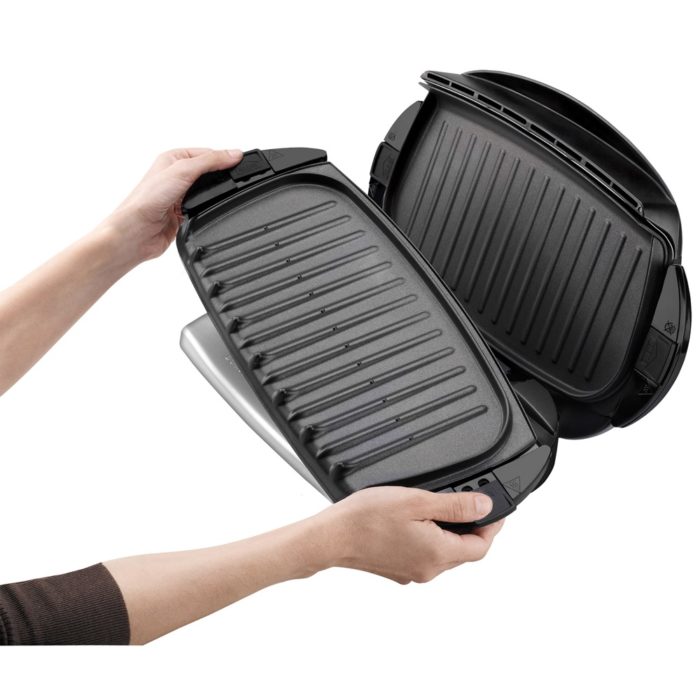Surely this title can’t be serious.
I’m a 26-year old red-blooded American male consumer, and my favorite product is a kitchen accessory. Honest.
Here’s some features of my favorite product:
- No touch-screen
- No buttons or flashing lights
- Can’t access or download adult movies
- Doesn’t play Angry Birds
- Not connected to other people or other sponges via Facebook
Despite all those shortcomings, and more, I love this product. This should all probably surprise you, or upset you. It should certainly upset every major consumer products manufacturer. Except one: The company that makes the George Foreman Grill, and concurrently, the Foreman Grill Sponge.
Yep. That’s it.
Here’s why I love the Foreman Grill Sponge (FGS):
First: The FGS takes a real (but incredibly subtle) problem and absolutely, positively obliterates it.
It doesn’t fuss around with trying to be cool or flashy. That’s often a hallmark of a solution in search of a problem. The nascent phenomenon of TVs and phones with curved screens is an example of this. You’re inclined to say “Wow!” because it’s different and heavily advertised and maybe if you use it you’ll win favor with someone you’re attracted to. I doubt anyone said “Wow!” when they saw their first FGS.
The Foreman Grill is prone to collecting the burnt residue of the foods you’ve just cooked, and essentially needs to be cleaned after every use. I believe when the Foreman Grill originally came out, it didn’t come with any cleaning paraphernalia — you used the sponge you already had in your kitchen.
If I asked, back in the day, “What’s the worst aspect of your Grill?” to a hundred Foreman Grill owners, I’d guess the heavy majority would say “cleaning it is super annoying.” If I followed-up and asked “What would you fix,” my guess is the responses would blame the range (“make the range less sticky!”) or blame the user (“make me a better cook!”), but never the sponge. The sponge is a known entity; everyone above age 5 is an expert at using it, and it should hardly be blamed for any of this mess because it was still in the cupboard while you were stupid and not paying attention and subsequently overcooking the chicken. I’m sure if you asked “How do you rate your sponging experience,” respondents would simply say “yeah, it’s fine.”
Here’s the difference that Human-Centered Design brings to the table: I wouldn’t ask that second question, “What would you fix?”
Instead, I’d watch users go through the entire process of cooking a meal on their Foreman Grills. And under those circumstances, what should stick out plainly is the aggravated way home-chefs use their sponges to clean. The sponge is flat and designed to clean flat things. The Grill’s range has a very distinct bulbous shape, like this:

As a result, with a regular sponge it’s relatively easy to clean the most-exposed surfaces of the grill, and relatively impossible—requiring clawing with the corner of the sponge (damaging it), using your fingernails (dirtying those), and no shortage of foul language (disappointing your parents)—to get the recessed nooks and crannies. It’s doable, but it’s not pleasant.
Enter the FGS: A sponge which contours exactly to the grill’s humps. It’s infinitely better at reaching the nooks, and moreover, it just feels mechanically and cathartically nicer to slide perfectly along the grill’s rails. The same “Ahhh” feeling you get when you place the correct piece in the middle of a puzzle, or just generally when things fit perfectly into other things. Product functionality: Massively improved. Product experience: Massively improved. Learning Curve: Completely intuitive. Those are the marks of an insanely great product.
Incidentally, I once wrote this much on my short-lived side website, only there I used 20 words instead of roughly 700.
Second: Like any good Made-for-TV product, here’s the part where I say “But Wait—There’s More!!”
Sponges are a heavily commoditized product. I doubt even Martha Stewart has a favorite sponge brand. (Maybe she prefers lavender sponges to blue?) Perhaps I’m just not a sophisticated sponge consumer, but I know even paper towels try to differentiate in their mopping ability, thickness, and quilted-ness.
I looked on Amazon quickly. (There doesn’t seem to be a sponge-equivalent of quilted-ness, alas.) Depending on the bulk quantity you’re buying, sponges cost $0.50 to $1.00 per unit. The FGS, on the other hand, seems to typically come in packs of three, and sponges cost $2 apiece, or $6.00 total. Which means they’re convincingly commanding a 100%-300% premium on an item that has the most basic, obvious, and clearly copy-able product innovation possible.
And that, to me, is absolutely beautiful.

